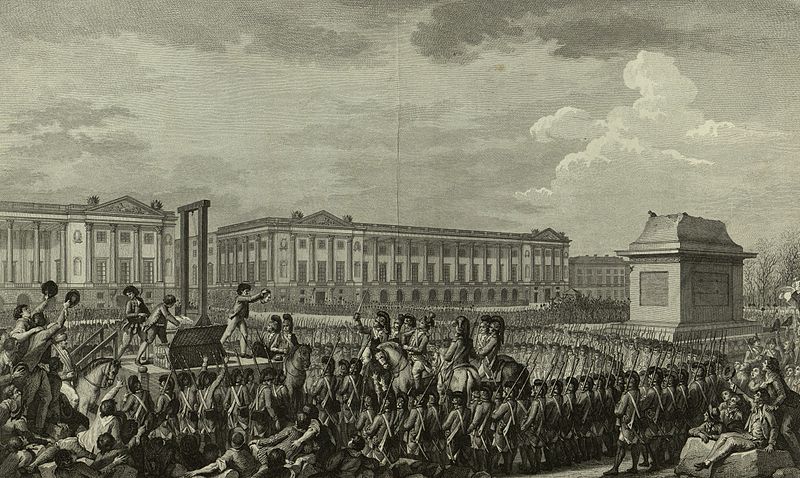First Execution by Guillotine, 1792
 |
| Louis XVI's execution by guillotine in 1793. |
The guillotine was intended as an equalizer, since it would be used on all executed criminals, regardless of class. It was also believed that it would cause a more humane death by instantaneous execution. Other reforms banned the use of torture, the confiscation of property, and punishments against the family of the accused.
 |
| "I cut off your head in the twinkling of an eye..." |
Guillotin's name became inextricably linked to the machine when, in a speech to the Assembly, he said, "Now, with my machine, I cut off your head in the twinkling of an eye, and you never feel it!" The statement was reported to the public, became the subject of a popular song, and after that Guillotin's name was forever tied to the device.
Guillotin came close to being put to death by the guillotine himself. He had been imprisoned after receiving a letter from a condemned man (who wanted him to look after his wife and children) which immediately put him under suspicion. Guillotin was freed after Robespierre fell from power. (There was another Dr. Guillotin who was executed by guillotine, but he was no relation.) Guillotin's family petitioned the government to change the name of the machine; when the government refused, they changed their own name.
The first person executed by the guillotine, by the way, was Nicholas Jacques Pelletier. He was a highwayman who had assaulted and killed a man in Paris, and was arrested the same night. He was sentenced to death on December 31, 1791, but had to wait until April to be executed. The National Assembly had outlawed all executions except by guillotine, but the guillotine had not yet been built. When the execution finally took place, the crowd was disappointed by the lack of drama.
France continued using the guillotine as the only legal method of execution until capital punishment was outlawed in 1981. The sole exceptions were executions decreed by military courts, which mandated trial by firing squad, and certain crimes against national security.
 |
| Samantha was honored on a Soviet stamp. |
Samantha Smith is Invited to the USSR, 1983
Samantha Smith was nine years old when she wrote to the new Soviet General Secretary Yuri Andropov. She congratulated him on his new appointment, and expressed her worries about the Soviet Union and the United States going to war. She wanted to know if Andropov was going to vote for war or not, and why he wanted to conquer her country.Her letter was published in the Soviet Pravda, but Samantha wasn't satisfied. Andropov hadn't answered her letter. She wrote again, this time to the Soviet Union's Ambassador to the United States, asking him if she would be receiving a reply. This time Andropov wrote back.
Andropov's response, which she received on April 26, 1983, stressed the wish of Andropov and the Soviet people for peace, and invited Samantha to come visit them. She visited the Soviet Union with her parents and spent two weeks there. She was amazed by the friendliness of the Russian people, and later wrote a book about her experiences. Samantha charmed the Russian people, but many Americans considered her to be an unwitting pawn serving Soviet propaganda.
Samantha later went to Japan, where she visited Prime Minister Yasuhiro Nakasone and attended a Children's Symposium. She became a celebrity in the United States -- enough to attract a stalker, Robert John Bardo, who latter stalked and killed actress Rebecca Schaeffer. She starred in a television series, Lime Street, with Robert Wagner.
On August 25, 1985, Samantha was killed in a accident when the commuter plane she was traveling in crashed on landing, killing all passengers and crew. Over 1,000 people attended her funeral. In her home state of Maine, the first Monday in June has been declared Samantha Smith day. The Soviet Union has issued a commemorative stamp in her honor, and named an asteroid after her.
No comments:
Post a Comment